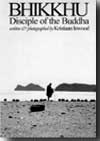| Our Publications | ||
| Books by Title | ||
| Books by Author | ||
| Books by Country | ||
| E-books | ||
| About | ||
| Orchid Press E-books | ||
| Distributed E-books | ||
| Our Bookshop | ||
| About Us | ||
| Browse Shop | ||
| How to Buy | ||
| Contact Us | ||
| WE BUY BOOKS AND LIBRARIES | ||
|
||
Book Reviews

Bhikkhu:
Disciple of the Buddha
byKristiaan Inwood
Second revised printing Orchid Press 2005 (1st ed. privately Printed 1981). 208 pp., 178 b&w pl., 215 x 152 Softcover
ISBN-10: 974-524-059-1 $22.00
ISBN-13: 978-974-524-059-9
A Farang Monk’s Story
Book review by James Ekhardt
(The Phuket Gazette, Febrary 2006)
There’s no way to plunge more deeply into an alien culture than by joining its religion.
Which is what Roger Welty did nearly 40 years ago. His first year as a monk is chronicled in prose and photographs in Bhikkhu: Disciple of the Buddha (Orchid Press, Bangkok, 2005, 206pp). The author and photographer is Kristiaan Inwood who produced the original and quirky Siamese Bestiary, reviewed here a few months ago.
It is not uncommon today for Westerners to become ordained as Buddhist monks, but it was certainly a novelty back in 1967 when Roger Welty, a 38-year-old Californian, donned the saffron robes and devoted himself to “a way of life that encompasses philosophy, psychology, physiology, mysticism, magic, cosmology, metaphysics, ritual and religion; a religion that has inspired much of the world’s finest architecture, painting and sculpture.”
Welty left behind a souring marriage and a prosperous business career in Manhattan to do the usual searching for enlightenment trip in the East. On the advice of a Thai monk, he lived in Thailand for two years, taught at a Thammasat University and learned the language. He was prepared for his ordination.
Inwood begins his account with Welty explaining in his own words his attraction to Theravada Buddhism and why he chose to be ordained in Thailand: “In our world as it is today, it must be an unusual country that welcomes foreigners, takes them into its monasteries, feeds and cares for them, thus providing them with this rare opportunity for self advancement.”
The author then backtracks to explain the historical background and teachings of Buddhism.
The second chapter is a meticulous description of Welty’s ordination at Wat Pleng, a 200-year-old monastery on the outskirts of Thonburi and his first weeks of adjusting to his daily new routines of chanting, begging, studying, self-confession, meditation. Central to his life are his daily tutorials by the abbot, Acarya Praderm. Inwood presents a fine portrait of this ideal monk:
“Acarya Praderm is an impressive abbot who exemplifies the selflessness that all bhikkhus should emulate. He radiates a serenity and wholesomeness that give monks and meditators under his care a great deal of confidence. His personality is evidently born of knowledge and awareness. Self-possessed, unaffected, his every action is calm, untainted with passions. This does not mean he is emotionally cold. He enjoys humour, laughter and personal contacts as much as anyone, but his actions appear completely without motives of personal profit or pride.”
The climax of Welty’s stay in this wat is a month-long, silent, solitary, intense period of Vipassana meditation. As described by Inwood in 15 dense pages, this is a harrowing personal ordeal tinged here and there by ecstasy. To readers like me this is an unknowable experience, but Inwood and, obviously, Welty do their utmost to put words to it.
“A month’s meditation demands almost superhuman determination to maintain sincere, objective awareness of each passing second of waking consciousness, an awareness that ideally lasts from the first waking moment until the last instant before sleep. During the month’s five-hundred-odd hours of awareness, meditation can be an unnerving mixture of exhilaration, enervation, boredom, excitement, terror, pain and depression. The meditator is subject to fierce bubblings of his mind. Forbidden the ‘escapist’ activities of reading, writing and talking, he finds himself confronted by subconscious mechanisms, thoughts, prejudices, ‘skeletons in the closet’, memories, fears and fantasies. . . A month of this can be absolute hell.”
Welty eventually winds up on an idyllic mountaintop retreat with two other monks on the undiscovered island of Koh Phang Ngan. The book ends here with him deciding what to do with the rest of his life. He stayed on in Thailand for a distinguished career as a writer and teacher till his death a few years ago. One wonders what he would have made of the Full Moon Party - an invasion of the Visigoths.
The book is illuminated with 178 striking black and white photos which lend great immediacy to the tale.
Read a review from The Nation [More Orchid Press Reviews]
PO Box 70, Trinity TB, NL, A0C 2S0, Canada
Telephone: +1 709-330-4703